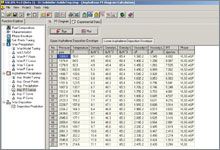dbrSOLIDS
Predicting precipitation points
dbrSOLIDS fluid analysis software is a Microsoft Windows-based application that predicts the thermodynamic precipitation point of waxes and asphaltenes with knowledge of reservoir fluid compositions. Module accuracy has been confirmed by laboratory testing.
Precipitation of wax and asphaltene is manifested primarily through changes in temperature, pressure, and composition. Composition affects both, but temperature is more significant for wax precipitation, and pressure is more significant for asphaltenes.
A flow assurance engineer enters composition and experimental results into the application for prediction and tuning of wax and asphaltene onset points. The results affect field operating strategies to improve well performance.
Wax module calculations
The dbrSOLIDS software wax (or paraffin) module is a thermodynamic equilibrium model that predicts wax precipitation conditions.
A characterization procedure developed specifically for this application better describes the heavy fraction of the reservoir fluid for improved wax precipitation and fluid phase behavior predictions. The wax module is also a complete, simultaneous two- and three-phase (vapor-liquid, liquid-solid, and vapor-liquid-solid) model. In addition to the temperature at which wax will appear, it predicts the mass of precipitated wax and other physical properties for reservoir fluids.
Asphaltene module calculations
The dbrSOLIDS software asphaltene module is a compositional thermodynamic model based on equations of state and asphaltene molecular association. This model adopts the characterization procedure from the wax module. If available, the model can also use a saturate-aromatic-resin-asphaltene analysis to perform asphaltene precipitation calculations.

